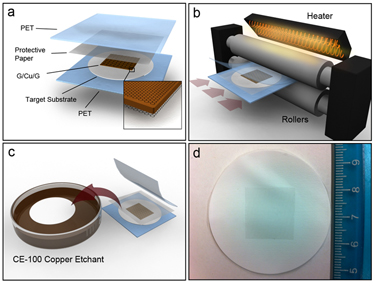Two layers of graphene can be brought together at an extremely close distance of just one nanometre - ten times closer than is possible for other, more traditional, materials. This is the new finding from researchers at the University of Manchester, led by Leonid Ponomarenko, who have observed very strong “Coulomb drag” in the double-layer graphene system.

Directly transferring graphene onto flexible substrate
Measuring Coulomb drag is good way of studying fundamental physical phenomena like electron-electron interactions and many body effects, such as the formation of electron-hole pairs (excitons).
Ponomarenko and colleagues experiment involved measuring the voltage in one graphene layer while applying a current through a second layer that was electrically isolated from the first using a 1 nm-thick boron nitride spacer. This is the first time that two 2D material layers have been brought so closely together in this way.
Coulomb drag
The Manchester team found that the electrons carrying current in one of the layers “drag” the electrons in the other, so generating a small but measurable voltage. This effect is known as Coulomb drag. The researchers made sure that the layers did not touch, so as to avoid electron tunnelling effects. The experiment itself was fairly easy to set up, they say, but the main difficulties lay in manipulating the individual graphene layers and boron nitride in a clean room environment.
“In the past, researchers studied Coulomb drag in traditional two-dimensional electron systems, such as gallium arsenide quantum wells,” explains Ponomarenko. “However, with the advent of graphene and graphene-based heterostructures the effect can be studied at a qualitatively new level.”
Unexpected observation at charge neutrality point
The fact that individual graphene layers can be brought so close together means that interactions are much stronger in such a system and we can start looking for interesting physical phenomena hitherto only predicted, he told nanotechweb.org. Most unexpectedly in our work, we observed very strong Coulomb drag at the so-called charge neutrality point. Here, the nominal charge density is zero, so, in theory, drag should vanish, he said.
“Although the new result has no practical applications at the moment, because the Coulomb drag effect is relatively weak, the fact that we have observed it at nearly room temperature gives us hope for identifying possible applications in the future,” he added.
The researchers say that they are now busy looking for graphene interlayer excitons. “The interlayer exciton is a stable bound state between the electron in one layer and a hole in another,” explains Ponomarenko. “If successful, we then hope to observe Bose-Einstein condensation of these excitons. This will be a very exciting experiment.”

